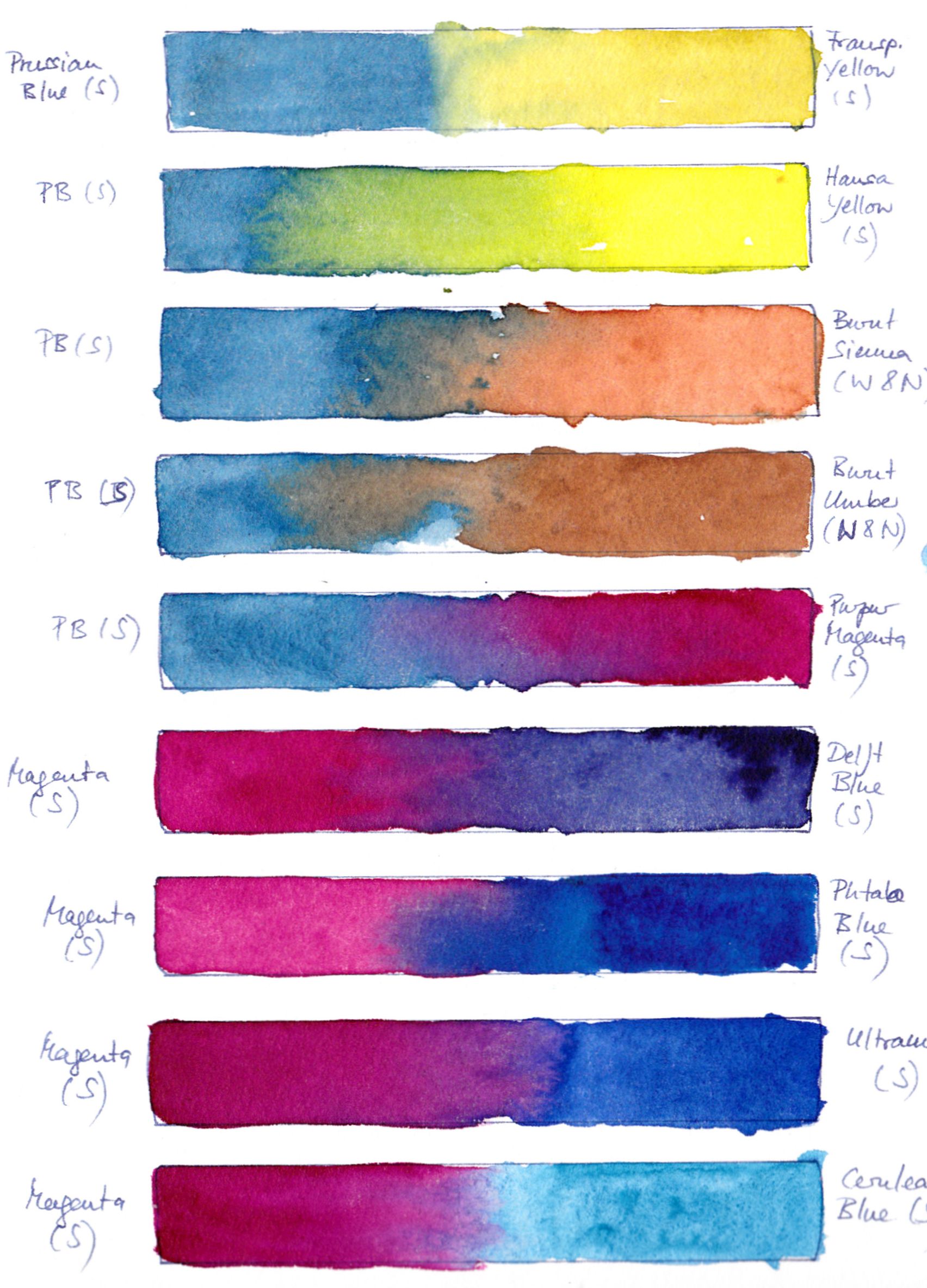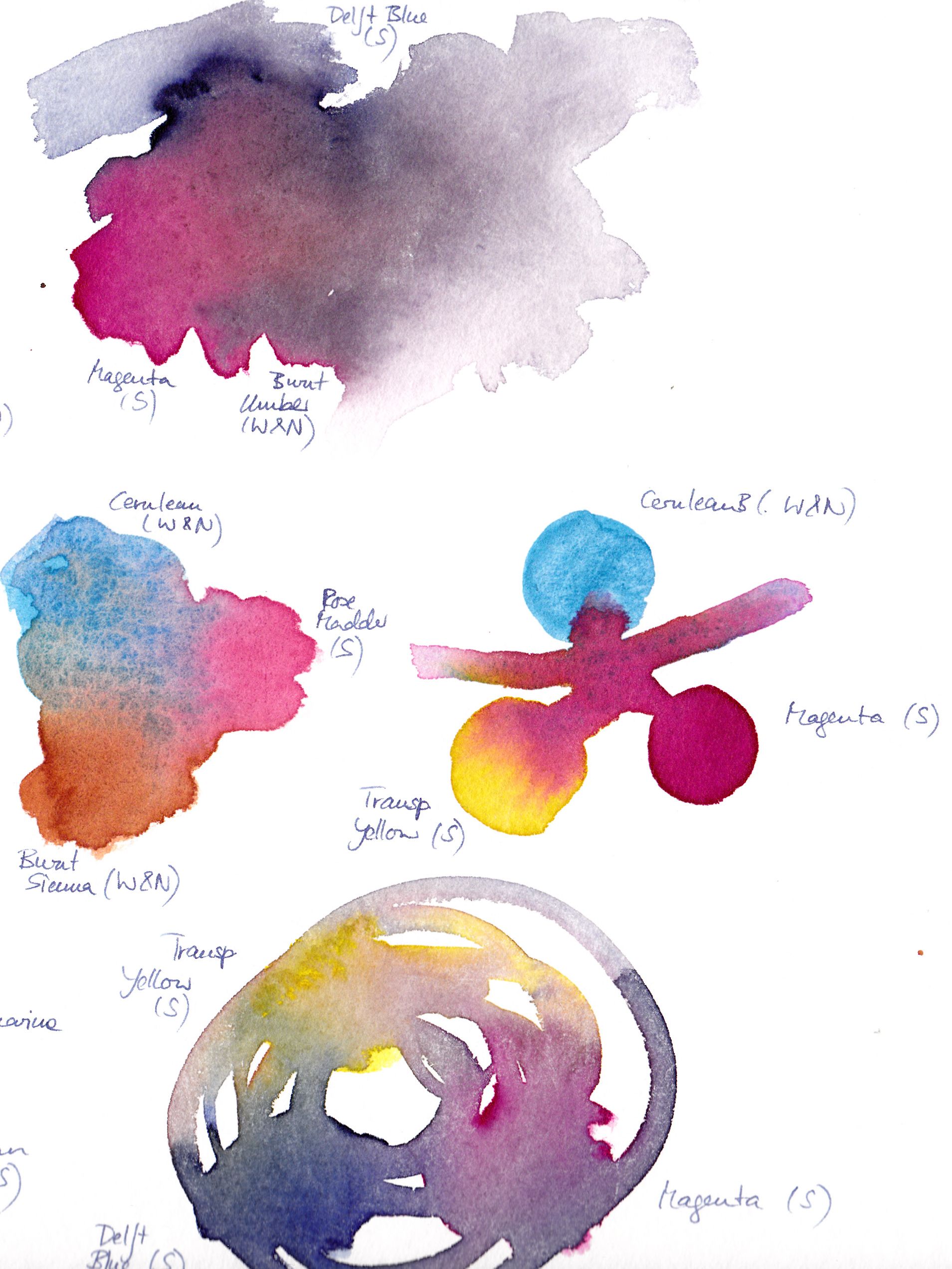

The specifics of how colours mix are of obvious importance if and only if you mix colours yourself. You don’t need to since you can buy all kinds of ready-made premixes in tubes or pans. The mixes contain certain amounts of the pure pigments which make up the colours, green e.g. containing (some kind of) yellow and (some kind of) blue. The advantage of using pure pigments, i.e. paints which are not pre-mixed, is that they give you clean and unmuddied tints when mixed with other pure paints. When too many pigments are involved, you get dull mixes which is great if that’s what you’re after but frustrating if it’s not. With pure pigments, the mix always does what you want it to do which saves you time and trouble. Also, the colours radiate more, particularly so if they are translucent. On this last point: you might think that all watercolour paints are but that’s not the case. Cadmiums are heavy and near opaque, Napels Yellow is opaque and the Cerulean Blue I used in these swatches is doing strange things, too. I felt that it granulated a bit too much. The blobs of paints are attempts at mixing greys. You need three primaries for this but it only works when the proportion is correct. Magenta will make a mockery of the other participants in the mix if you take too much of it.
Die Hintergründe des Farbmischens sind natürlich nur dann interessant, wenn man seine Farben selbst mischt. Das muss man nicht, denn es gibt fast jede Mischung fertig in Tuben oder Näpchen zu kaufen. Die Farbpigmente, die die Mischung ergeben, sind zumindest oft auf den Tuben oft aufgedruckt; Grün ist eigentlich immer eine Mischung aus einem Gelb und einem Blau. Der Vorteil des Malens mit reinen Farben, die nur ein oder zwei Pigmente enthalten, ist, dass sie saubere Mischfarben miteinander ergeben. Wenn zu viele Pigmente zusammen kommen, vergraut die Farbe. Das kann man wollen, denn selbst angemischte Grautöne sind sehr schön, mal eher bläulich, mal eher ins Rötliche neigend. Aber wenn man es nicht möchte, dann ist es frustrierend, keine klaren Farben anmischen zu können. Daher arbeite ich gern mit reinen Pigmenten, also weitestgehend ungemischten Farben. Ich mische mir, was ich brauche, einfach selbst. Ein weiterer Unterschied besteht zwischen lasierenden und deckenden Aquarellfarben. Kadmiumfarben sind in der Regel deckend, Neapelgelb ist deckend (eine ganz mächtige Farbe, ich mag sie!) und Coelinblau ist in manchen Varianten auch ziemlich heftig. Meins granuliert sehr, das kann man in der Mischung mit Sienna gebr. und Rosa Krapplack sehen. Unten der große Kringel ist der Versuch, ein farbiges Grau zu erzeugen, indem ich drei Primärfarben mische. Das Männekin oben drüber war auch so ein Versuch, aber Magenta hat die beiden anderen Farben übertönt. Es ist gar nicht so einfach, eine Methode des praktischen Farbtestens zu finden!

I love seeing how colors merge and blend, loved your chart and the post. cheers, Debi
You’re so welcome, Debi! You know what, I love it too and I can’t tell you enough how I enjoyed making these little charts! Thank you for commenting! Greetings from Berlin, Antje.
yes!! doing charts like that, is fun. and relaxing! 🙂
Hi Antje. My mother did these sorts of studies and had them clipped to her easel. Wish I had kept them.You are a wonderful teacher. Barbara